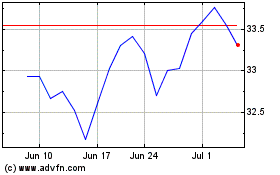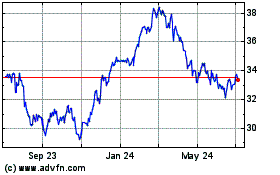Railroads Prepare for Quick Turnaround
April 23 2020 - 2:09PM
Dow Jones News
By Paul Ziobro
After having a front-row seat to the economy seizing up, freight
railroads are keeping their workers and locomotives on standby to
quickly help get things moving again.
When that happens is anyone's guess.
Railroads have retrenched during the coronavirus pandemic as
they face a drop of around 25% in their near-term shipping volumes,
which have been roiled by factory closures, declines in business
activity and another sharp slump in coal shipments due to the
oil-price rout.
CSX Corp. and Union Pacific Corp. have taken hundreds of
locomotives offline in recent weeks, reduced the number of trains
being run to better align with plunging demand and sent workers
home.
That all could reverse quickly.
Instead of laying off or furloughing its transportation workers,
CSX has worked with its unions to allow employees to take unpaid
time off or switch to a schedule where they work one week a month.
Benefits are paid under either choice.
The arrangement allows CSX to recall workers to service in as
little as 48 hours, whereas returning from furloughs has a 15-day
window.
CSX Chief Executive Jim Foote said that such a setup is needed
because of the uncertainty around how long the downturn would last.
If it knew there would be a prolonged slump, CSX could wait to
figure out when it would need more workers to run trains.
"I don't have the luxury of worrying about that in 12 months,"
Mr. Foote said in an interview Wednesday. "I have to be thinking
that it can turn around in two months."
Union Pacific has set up a similar work status in lieu of
furloughs so that the railroad can call back workers quickly.
Locomotives are also being parked but maintained so that they
can get back to hauling more freight quickly. "They are in a state
where within hours, we could turn them back on and put them out to
the fleet if we need to," Union Pacific Chief Operating Officer Jim
Vena said on an earnings call Thursday.
Railroad executives say that an overhaul of operating strategies
in the past few years has helped them contract operations quickly
during the pandemic and set them up for a rebound. CSX, Union
Pacific and other railroads have all been focused on running fewer
and longer trains that stick to tight schedules while cutting costs
and jobs to improve profitability.
"We have for a long time thought and worried about trying to
build agility into our decision making and reaction time," Union
Pacific CEO Lance Fritz said in an interview Thursday. "We are way
better at that today."
As the pandemic hit the U.S., railroads have been able to cut
costs further. CSX and Union Pacific both reported higher
first-quarter profits as costs tied to labor and fuel expenses
dropped faster than the decline in shipments and revenue.
They may not be able to cut costs enough to match the steeper
shipping-volume declines in the second quarter, when overall
shipping volume is down around 20% or more.
Both railroads withdrew most of their forecasts for the year, as
the duration of the downturn remains unclear.
"Our collective belief at this point is it's sharp and deep,"
Mr. Fritz said. "It's going to last for a while, and recovery is
going to be some kind of ramp but probably not terribly steep."
Mr. Fritz said Union Pacific has a lot of extra shipping
capacity that can be filled if the economy were to rebound
faster.
"If the economy were to snap back, we can respond to that pretty
darn quickly," he said.
Write to Paul Ziobro at Paul.Ziobro@wsj.com
(END) Dow Jones Newswires
April 23, 2020 13:54 ET (17:54 GMT)
Copyright (c) 2020 Dow Jones & Company, Inc.
CSX (NASDAQ:CSX)
Historical Stock Chart
From Mar 2024 to Apr 2024

CSX (NASDAQ:CSX)
Historical Stock Chart
From Apr 2023 to Apr 2024
